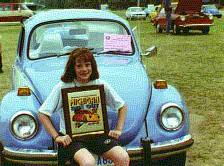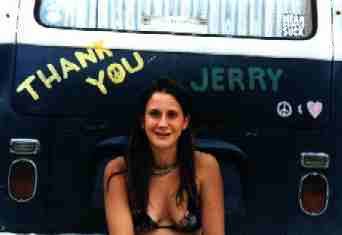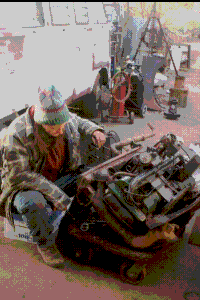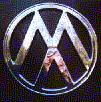What Should We Look Out For?
More Free Advice from the Junkyard
From: "Peter Dixon"
Date: 11/9/97 12:57AM
Subject: What should we look out for?
Address: To: FreeAdvice@acvwjyro.com
Greetings!
My partner is looking for a VW beetle (you know...
childhood fantasy thing), and we would love some advice
of what things to look out for when veiwing
said cars. Where do they rust...which parts can show if the car
had a shonky owner etc etc...?
Any advice will be welcome.
Ta
Peter and Megan
aabr@zip.com.au
If you cast back 100 years or so, you'd be buying a horse and maybe carriage
instead of a car. Pretty straight forward, not a terrible lot of things
to examine with either, although even then unscupulous persons could
hide defects and bad horseflesh. "Horse traders" is what they were called
and it still carries a negative connotation.
Well, those guys - or at least their ideological descendents - are still with
us in the guise of used car salesmen, politicians, and television anchors.
A few years back, Dale from southern Ohio, stopped by the Junkyard with a
primo 64 bug - freshly painted and gleaming in the sunlight.
Just bought it, but wanted to sell it. Needed the money for something.
After Kevin looked it over and crawled underneath, you should have seen
Dale's face when the high offer was $500. He's just spent $2000 on it.
But then, he'd never been underneath, where the floor and rocker panels
had been fabricated out of a myriad collection of small scraps of metal
pop-riveted together. He'd bought it from a horse trader.
But if Dale hadn't been trying to recoup his money, he never
would have known about the floor, and chances are to this day
he'd still be happy with that car, waxing it on Sundays and driving it
all Summer long.
As with any project, the chances of success are enhanced by carefully
considering the goals. Why do you want to acquire an old bug?
Some possible reasons:
-
Basic transportation
-
Shows and meets
-
That Deadhead stuff
-
Just for fun
-
Investment
Each of these categories looks to a different type of VW as the perfect
acquisition. Basic transportation demands mechanical integrity, while
- on the other hand - those show cars that come to the VW shows on trailers
don't even have to run. Those Deadheads would much rather have a microbus
than a bug, and who knows what the investors are looking for.
If you want the bug just for fun, then - oba! oba! - the world
is your air-cooled oyster.
AJ says that his favorite beetle was Suzy, a 74 super beetle
named after its original owner, with rust holes and dents on every
fender and surface. He drove it all
Winter to work up in Willoughby - a good 50 miles from Richfield -
hitting the road at 4 in the morning
when all of the other traffic had 4 wheel drive.
The driver's side rocker panel had disappeared long before,
but that gap was stuffed with cardboard and carpet remnants,
the front hood was held closed with a bunji cord,
and he ran a flexible
hose from under the rear seat to heat the windshield.
And the reason he liked the car so much was because on those frigid
Ohio mornings when the Canadian north wind
off Lake Erie was piling snow on I-271
and all the plow drivers were still huddled around the coffee urn at
Gastown, Suzy would cruise on up the interstate
with AJ in his snowmobile suit and boots, driver's side window wide open,
and have no trouble at all getting through.
12 inches of snow - freezing rain - none of it mattered.
"Function is beauty." John Dewey said that, and it's still true.
The Hoopster, on the other hand, wouldn't have been happy with Suzy.
He and his daughter Jer travel to VW shows around the Midwest
in Josephine, a 72 super beetle. Josephine
has accumulated a collection of plaques and trophies.
 The Hoopster's criteria for buying an old bug
would probably preclude missing rocker panels, rusted fenders,
and headlights that point like searchlights
into the air. Much more important to the Hoopster would be
OEM parts and equipment - a car that is still pristine.
Maybe not original paint, but then again - that could be points at a show.
Otherwise, might be the modified class.
The Hoopster's criteria for buying an old bug
would probably preclude missing rocker panels, rusted fenders,
and headlights that point like searchlights
into the air. Much more important to the Hoopster would be
OEM parts and equipment - a car that is still pristine.
Maybe not original paint, but then again - that could be points at a show.
Otherwise, might be the modified class.
These examples would seem to be opposite ends of the scale,
but the fact of the matter is that there are a lot of other ends
to this scale as well.
I'm not sure, for example, why Pam originally bought
Sunny (68 type II),
but my guess is that it had something to do with being a vegetarian and going
to Grateful Dead concerts. As with most VW owners, it did not
take her long to discover that an old bus can be an expensive thing
to maintain if someone is charging you to do the work.
The $750 clutch job taught her that lesson.
 Pam first came down to the Junkyard looking for the hinge
arrangement for her pop-top, but she hung around and that Winter she laid
Sunny up and rebuilt her engine at the Junkyard -
splitting the case and replacing everything that looked worn or suspicious.
Pam first came down to the Junkyard looking for the hinge
arrangement for her pop-top, but she hung around and that Winter she laid
Sunny up and rebuilt her engine at the Junkyard -
splitting the case and replacing everything that looked worn or suspicious.
Pam had never done this sort of thing before, and aside from learning
the basic knowledge of how to work on an engine, she gained
a lot confidence as well. So much so, that the following year she was
a mainstay of the Junkyard staff, anxious to assemble and disassemble new
things, anxious to learn how they worked.
AJ says:
"Life was comfortable in those days. 'Hey Pam, we're ready to take
out the trans', and she'd be sliding under the vehicle, wrenches in hand."
When she
roached her engine down in Tennessee
Pam set to building a new one with her old heads and parts
garnished from new friends in the region.
And it worked just fine. In the space of 5 days she had
put together an engine and was back on the road.
 When Pam got the chance during Spring break, she brought the
engine to the Junkyard and rebuilt it one more time. Just to be sure.
When Pam got the chance during Spring break, she brought the
engine to the Junkyard and rebuilt it one more time. Just to be sure.
But later Sunny had some bad luck and the steering pivot on the axle beam
rotted loose - a hard thing to fix and especially hard to fix well -
so Pam let Sunny sit in the Hocking College parking lot
and in the late Spring she was up to
Canada on a school expedition where she met Dave, a bush pilot,
they got married and moved into a cabin up in the northern
Canadian wilderness and just recently had a baby, Jade Alexandra.
Not a timid one, she.
Pam donated Sunny to the Junkyard, and one clear Autumn day,
AJ and Mario drove down to
Nelsonville and recovered the engine and trans and swapped wheels and rims,
then towed the remnants over to Gumby's shop.
Pam's engine, rebuilt less than 300 miles ago, sat in Mario's garage
for about a year, getting moved over by the compressor or moved over
by the stove, depending upon the changing projects. When this Spring came,
and Mario turned his attention to the dune buggy, he decided that
the old engine would have to be replaced. And what better candidate
than that shiny green engine that had just been rebuilt?
And here's the skinny of it. Mario took
that engine which Pam had so meticulously built time after time
down to Mr Appleby's
for Memorial Day in the dune buggy. Actually, he wasn't driving - Madame
had the wheel, trying to climb the vertical side of the Dirt Knob with
the dune buggy at roughly 80 degrees from horizonal, churning and churning
with the wheels spitting an el niño of dirt, all of the oil
in the crankcase sitting at the rear of the engine well away from
the oil sump, when it started making that terrible squeeeeeeeeling sound.
But Madame didn't notice, and after a minute or two, Pam's engine just
plain locked up, the dune buggy flopped end over end down the knob,
and Madame had his first indication that something was wrong.
Oil light? On a dune buggy?
So Pam and Madame are two different opposite ends of the scale.
And then there's the investors.
These are the guys who buy a bug in the hopes that it's value
will increase faster than inflation. But is it prudent to drive an
investment on the street? Or should it live under a tarp in a dusty garage?
And it doesn't really matter which end of which VW scale you think you fit.
Once you own a bug, you'll find your own ecological niche, subject to
change at any time. Just like Dale changed from happy waxer to disgrundled
investor in a single moment.
Here's the advice on buying a bug.
Look out for everything.
Drive it around the block. Crawl underneath. Use a magnet in search
of body work. Open the door and lift it, like you were trying to
turn the car over - looking at the base of the door pillar for movement.
Poke around under the fenders where the wheels throw all the water
and slush and road salt. STOMP on the brake pedal to see what bursts.
But most of all, if you are going to buy it, buy it because you like it.
Whatever's wrong with it is probably fixable.
If you are not going to work on it yourself,
put aside a small pile of money,
but in either case, be prepared for constant maintenance and repairs.
They are part of owning a beetle.
So, even if it's got more rust holes than Suzy, if you like it,
buy it.
If you change your mind later on, you can
always get rid of it, eh?
Some links to other pages dealing with the subject:

Back to the Junkyard
Click here to ask for your own
 free advice
free advice
c 1997 Air Cooled Volkswagen Junkyard of Richfield, Ohio
http://www.acvwjyro.com
"Where Advice Is Always Free"(216)659-3638
This story may be distributed only if it is not altered in any way
and is distributed freely without charge.
 The Hoopster's criteria for buying an old bug
would probably preclude missing rocker panels, rusted fenders,
and headlights that point like searchlights
into the air. Much more important to the Hoopster would be
OEM parts and equipment - a car that is still pristine.
Maybe not original paint, but then again - that could be points at a show.
Otherwise, might be the modified class.
The Hoopster's criteria for buying an old bug
would probably preclude missing rocker panels, rusted fenders,
and headlights that point like searchlights
into the air. Much more important to the Hoopster would be
OEM parts and equipment - a car that is still pristine.
Maybe not original paint, but then again - that could be points at a show.
Otherwise, might be the modified class.
 Pam first came down to the Junkyard looking for the hinge
arrangement for her pop-top, but she hung around and that Winter she laid
Sunny up and rebuilt her engine at the Junkyard -
splitting the case and replacing everything that looked worn or suspicious.
Pam first came down to the Junkyard looking for the hinge
arrangement for her pop-top, but she hung around and that Winter she laid
Sunny up and rebuilt her engine at the Junkyard -
splitting the case and replacing everything that looked worn or suspicious.
 When Pam got the chance during Spring break, she brought the
engine to the Junkyard and rebuilt it one more time. Just to be sure.
When Pam got the chance during Spring break, she brought the
engine to the Junkyard and rebuilt it one more time. Just to be sure.

 free advice
free advice